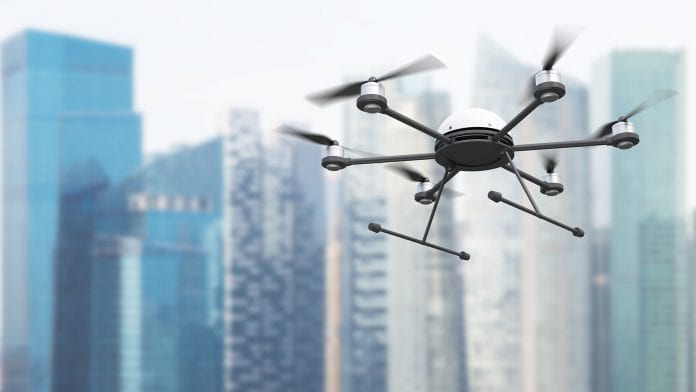
HEQ looks at smart disinfection technology which may help prevent the spread of COVID-19.
The COVID-19 pandemic has triggered the launch of a number of innovative research and development projects aimed at integrating smart technology into a wide range of disinfection processes in hopes of mitigating the spread of the virus. HEQ examines the efficacy of some of the innovative technological solutions designed to contribute to infection control efforts.
Disinfection tunnels: ‘potentially counterproductive’
Disinfection tunnels (DTs), or sanitisation tunnels, were briefly in vogue in China, India and Belgium in the early stages of the pandemic. Portable tunnels constructed from steel and PVC and measuring between 16 and 25 feet long are placed at the entrances to busy public spaces, such as markets, shopping centres, hospitals and business premises; users walk or cycle through the tunnels and are sprayed with a misted solution of sodium hypochlorite, a strong disinfectant. Disinfection tunnels can be static, where users stand in the middle of the tunnel and rotate while the disinfectant is sprayed in their direction, or dynamic, where the user’s path is sprayed as they move through the tunnel.
The evidence in favour of disinfection tunnels is sparse, however; and a study titled ‘Disinfection tunnels: potentially counterproductive in the context of a prolonged pandemic of COVID-19’ and published in the Public Health journal in June found that ‘any asymptomatic patient would remain [infectious] as the virus in the nasopharynx and respiratory tracts remains viable, hence contributing to a false sense of security among individuals. There is no way to test the benefits, other than mental satisfaction, which is just like the confidence wearing a cloth mask provides and thereby enables people to venture out into public places.’
The study’s authors concluded: ‘DTs are likely to be a wasteful expenditure of scarce resources. The World Health Organization has condemned the use of these sprays and tunnels and has released an advisory. The stress on these systems is not evidence based, unreliable, and flawed. While fighting this global pandemic, there is definitely a light at the end of the tunnel by practicing hand hygiene and social distancing, but not by passing through these DTs.’
Smart disinfection drones
Disinfection by drone was initially deployed in China to sanitise large, open public spaces when COVID-19 first hit; and has since expanded to Europe and the US. Drones designed for outdoor use can be deployed to spray targeted doses of disinfectant chemicals over large open air facilities, such as parks, stadia, exteriors of hospital buildings and carparks; while smaller drones equipped with ultraviolet disinfection technology can be directed to disinfect indoor spaces including offices, theatres and museums. Many disinfection drones are equipped with Artificial Intelligence (AI) technology to enable remote piloting or route programming.
Automatic vehicle disinfection
Particularly as more and more members of the public return to work following the easing of lockdown measures, public transport remains a key infection vector, due to its inherent combination of large groups of people in an enclosed space with limited availability of time and resources to complete a full disinfection of each vehicle between journeys. Passenger transport manufacturing firm Irizar has developed smart technology solutions to address the issue of infection control on buses, including a smart ‘access control’ camera system placed at the front of the bus. The smart camera is equipped with a temperature sensor, enabling it to detect passengers with an elevated body temperature above 37°C; and AI programming which allows it to detect whether or not a potential passenger is wearing a face mask, alert the driver with an acoustic signal and indicate to the unmasked passenger that they may not board.
In partnership with the Spanish Ministry of Health, Irizar has also developed an automatic disinfection system for buses and coaches. This system consists of a fixed outlet installed in the vehicle’s interior, which sprays disinfectant throughout the vehicle through a pneumatic nebuliser system. The disinfection process itself takes between 15 and 30 minutes, but the vehicle cannot then be used for another three to four hours.
‘Fever-finding’ smart helmets
KC Technologies, a Chinese smart technology firm, has developed ‘smart helmet’ headsets capable of detecting people with a fever from up to five metres away and emitting an acoustic alarm when the wearer is in proximity to someone with a heightened temperature. The helmet, which has already been adopted by police officers in the cities of Chengdu, Shanghai and Shenzhen, is similar in appearance to a motorcycle helmet; and according to its developers, enables users to ‘scan the body temperatures of hundreds of people and lock onto those with fever in less than two minutes’. In addition to an integrated infrared body temperature sensor, the helmet is equipped with an facial recognition technology, an augmented reality visor enabling the user to view a subject’s name and medical history, and a camera capable of scanning QR codes; as well as wifi, Bluetooth and 5G connectivity to facilitate the sharing of data with nearby hospitals.
Sustainable smart masks
Inspired during the COVID-19 lockdown to create ‘the safest, most innovative, and most beautiful mask ever’, Italian startup CLIU has developed a reusable face mask equipped with smart technology, featuring a transparent window allowing the user’s mouth to be visible to others, in order to optimise social engagement and avoid alienating people who rely on lip reading to communicate.
CLIU team member Fabrizio Lipani noted that the smart mask can be synced with a smartphone app, adding: “CLIU offers the hi-tech version with integrated Bluetooth, microphone and GPS. Thanks to the dedicated app, you can check your CLIU to ensure it is functioning correctly. Additionally, you can check the filter’s consumption status and access real time information on your health, such as heart beats and breathing quality.” Once the mask reaches the end of its lifespan, it can be dismantled and each component can be recycled.
This article is from issue 14 of Health Europa. Click here to get your free subscription today.










